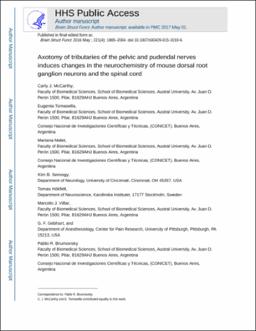| dc.description.abstract | Using immunohistochemical techniques, we characterized changes in the expression of several neurochemical markers in lumbar 4-sacral 2 (L4-S2) dorsal root ganglion (DRG) neuron profiles (NPs) and the spinal cord of BALB/c mice after axotomy of the L6 and S1 spinal nerves, major tributaries of the pelvic (targeting pelvic visceral organs) and pudendal (targeting perineum and genitalia) nerves. Sham animals were included. Expression of cyclic AMP-dependent transcription factor 3 (ATF3), calcitonin gene-related peptide (CGRP), transient receptor potential cation channel subfamily V, member 1 (TRPV1), tyrosine hydroxylase (TH) and vesicular glutamate transporters (VGLUT) types 1 and −2 was analysed seven days after injury. L6-S1 axotomy induced dramatic de novo expression of ATF3 in many L6-S1 DRG NPs, and parallel significant downregulations in the percentage of CGRP-, TRPV1-, TH- and VGLUT2-immunoreactive (IR) DRG NPs, as compared to their expression in uninjured DRGs (contralateral L6-S1-AXO; sham mice); VGLUT1 expression remained unaltered. Sham L6-S1 DRGs only showed a small ipsilateral increase in ATF3-IR NPs (other markers were unchanged). L6-S1-AXO induced de novo expression of ATF3 in several lumbosacral spinal cord motoneurons and parasympathetic preganglionic neurons; in sham mice the effect was limited to a few motoneurons. Finally, a moderate decrease in CGRP- and TRPV1-like-immunoreactivities was observed in the ipsilateral superficial dorsal horn neuropil. In conclusion, injury of a mixed visceral/non-visceral nerve leads to considerable neurochemical alterations in DRGs matched, to some extent, in the spinal cord. Changes in these and potentially other nociception-related molecules could contribute to pain due to injury of nerves in the abdominopelvic cavity. | en_US |


